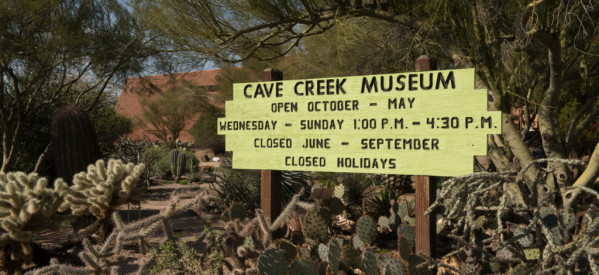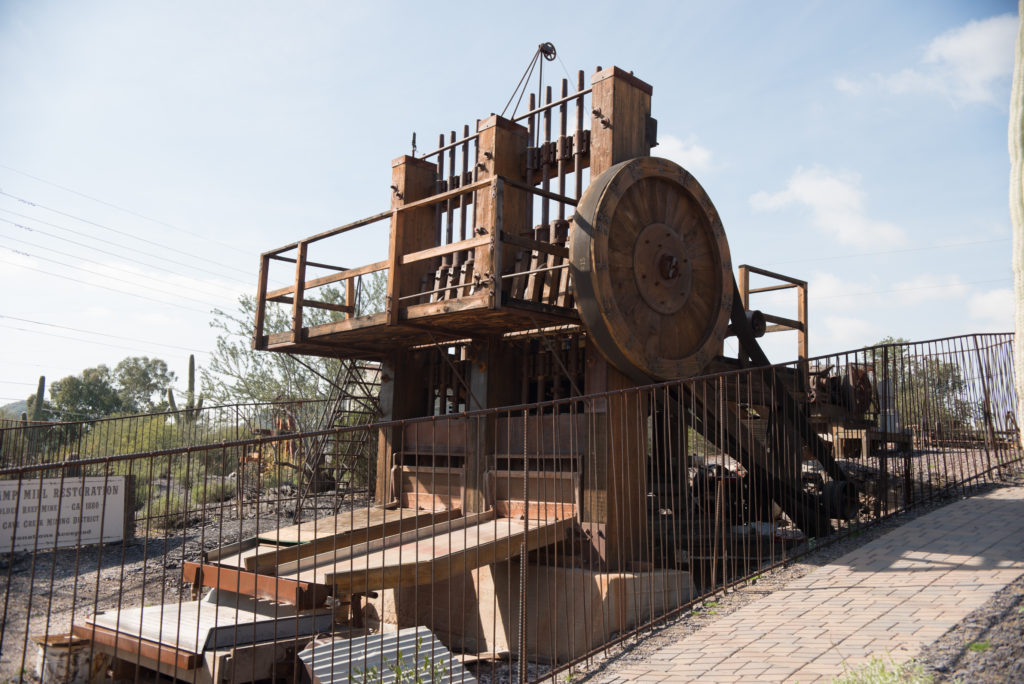Walk of Life

A stroll through Cave Creek Museum reveals the area’s rich history
By Lauren Wise
In 2019, Cave Creek is seen as a rugged, charming gem, nestled up against Scottsdale for easy access to a day of rodeos and cowboys, gorgeous hikes and ranching. But did you know about its storied history of artists and minerals—like how Cave Creek onyx was used to decorate buildings at the 1893 Chicago World’s Fair? Or the onyx vase sent to the White House during the Coolidge administration from the Phoenix Chamber of Commerce? What about that Cave Creek had its own version of Annie Oakley named Catherine J. Jones, aka Cattle Kate?
When it comes to local art and history, all of this is just the tip of the iceberg of what visitors can discover at the Cave Creek Museum.
This year marks the museum’s 49th year of preserving the legacy of Cave Creek and Carefree, from prehistory to current culture, through interpretive exhibits, mining equipment and gardens.
Easy to navigate over an hour or two, the Pioneer Wing is a great place to start for a heavy dose of history dating back to when Europeans and easterners headed west in the search for gold – and freedom and adventure. Artifacts from military service, mining and ranching populate the shelves here, dating from when the Cave Creek population blossomed after Henry Wickenburg discovered one of the richest gold strikes in Arizona in 1864. It’s no surprise that the Cave Creek mining district has an impressive history. At almost 144-square-miles, it was known for silver, gold, and of course copper – then called “red gold.”
Through displays such as painting, textiles and sculptures, visitors learn about the pioneers’ trek from the 1863-established Fort McDowell, which led to the building of Cave Creek Road to connect the small settlement of Phoenix with the army’s road. Eventually this lead to more permanent settlements and multiple ranches that succeeded and failed, including the Cartwrights’ Ranch that ran from 1880 to 1980.

Next, the Archaeology Wing offers a glimpse into a world of people who mastered desert living. Five locally discovered archaeological sites offer a look at excavated stone tools, baskets, pottery, projectile points, sandals, and more – including a model of a Hohokam pithouse that displays how the culture found true “air conditioning” within the ground, and timelines to detail the lives of two living cultures, Akimel O’Odham (Pima) and the Xalychidom Piipaash (Maricopa). Outside, check out Arizona’s only fully operational ten-stamp ore crushing mill, and watch the ten 1,000-pound stamps echo throughout the foothills. There’s even an exhibit on American cameras and tintypes, showcasing the progression of photography from gelatin film to digital.
New seasonal exhibits pop up alongside permanent ones as well, and 2019 brings artist Sharon Brening and photographer Herb Cohen to the forefront, both Arizona residents who specialize in portraying the people who help shape the American landscape. Brening’s vibrant traditional realist paintings of Native American children, horses and wildlife have earned her the title of the first woman to win the prestigious gold medal award for oil painting at the Annual Western Artists of America Show and Sale. Cohen’s stunning black and white photography features the Navajo nation and some of the “last cowboys” from the 1970s, capturing their disappearing way of life. Additional 2019 exhibits include Medicinal Plants of the Pima (did you know prickly pear lowers blood sugar?). Outdoors, visitors can enjoy the hands-on Desert Awareness Ecology Exhibit, thriving with desert animals and plants, a showcase of how they survive the desert landscape year round – a concern that, for current residents, is but a distant thought thanks to the past pioneers the museum is built to honor.
Cave Creek Museum
6140 E. Skyline Drive, Cave Creek
480-488-2764
Open October through May: 1 to 4:30 p.m. Wednesday and Thursday, 10 a.m. to 4:30 p.m. Friday, 1 to 4:30 p.m.
Saturday and Sunday (closed Monday and Tuesday)
Related posts
Leave a Comment
You must be logged in to post a comment.






